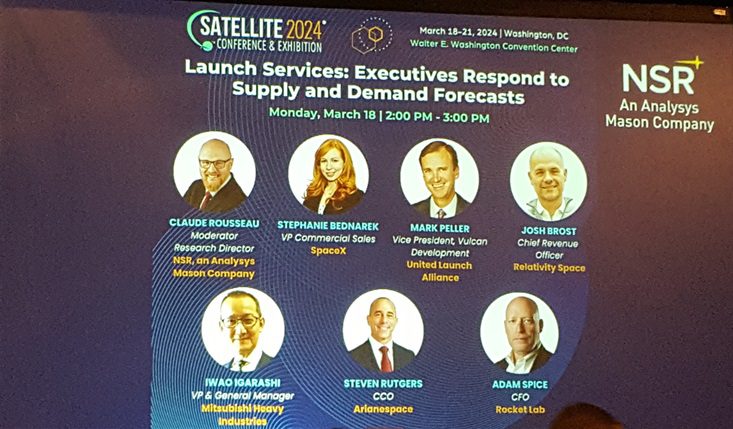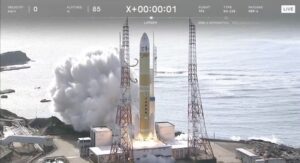On the first day of the Satellite 2024 conference in Washington DC, executives from global launch providers sat down to discuss launch supply and demand forecasts. Taking part were Stephanie Bednarek, VP Commercial Sales at SpaceX; Josh Brost, CRO, Relativity Space; Iwao Igarashi, VP and General Manager, MHI; Mark Peller, VP Vulcan Development, ULA; Steven Rutgers, CCO, Arianespace; and Adam Spice, CFO of Rocket Lab.

The Monday Launch Services Execs panel. Courtesy: Slingshot Aerospace/Matthew Wilson
All the panellists shared the view that there will be plenty of demand for their launchers. Arianespace and MHI are both former champions of the geostationary Earth orbit (GEO) satellite launch business. However, both companies have started to replace older launchers with next-gen vehicles and their panellists pointed out that their respective vehicles, H3 and Ariane 6, would be highly capable of deploying multiple satellites to LEO.
The multi-sat mission to LEO has become a hallmark of the launch industry in the past few years, exemplified by the SpaceX Falcon 9 and the Starlink constellation. The ‘newspace’ participants on the panel, Rocket Lab and Relativity Space, are both designing part reusable launch vehicles to compete in the market (while it is hoped that the economics of H3, which is already built, and Ariane 6 will still be competitive, they are not reusable).
After expressing his excitement, presumably mixed with relief, at the successful second launch of the H3 rocket in February, Iwao Igarashi of MHI said the company planned to conduct six H3 launches per year initially, before ramping up to eight flights. Of these, he expected 3 per year to be utilised by the Japanese government, with the remaining five slots available for the commercial market. It was Igarashi’s hope that satellite operators of both large and small spacecraft would utilise the available capacity of the H3 rocket.
Steven Rutgers, representing Arianespace, informed the audience that the maiden launch of his Ariane 6 rocket was scheduled for June this year. This rocket has suffered a series of developmental delays, pushing back its first launch attempt by over two years. Getting the rocket up and running is critical to Arianespace given that it retired its previous-generation rocket, the venerable Ariane 5, in 2023.
The Ariane 6 is expected to launch at a rate of 10 per year when in full flow. This will be needed because, as Rutgers declared, his company has a full manifest of 30 missions awaiting the rocket, enough to keep it busy for 3-4 years. To increase the launch rate of its new vehicle, he said Arianespace had been investing in new technology and infrastructure at its launch site in Kourou, French Guiana. This included constructing a new launch pad for the Ariane 6 complete with an enclosed mobile gantry, which will house the launch vehicle and its payload ahead of launch. The gantry allows for easier access to the whole stack for any work that needs to be done pre-launch and will be retracted leaving the rocket in place ready for lift-off.
Rocket Lab has also taken on a large project to support its new medium launch vehicle: Neutron. It is building a new production facility and launch pad at the Mid-Atlantic Reginal Spaceport, Wallops Island, Virginia, US. CFO Adam Spice said that, if all went well, the company hoped to be able to conduct the maiden flight of the Neutron by the end of this year, or in early 2025. Unlike Rocket Lab’s previous vehicles, the Neutron rocket is a part-reusable system with its first stage designed to return to the launch site and conduct a propulsive landing.
Relativity Space is developing the Terran R rocket which, like Rocket Lab’s upcoming entrant, is designed for first-stage reusability. Of the launch vehicle companies represented on the panel, the launch date for Relativity Space’s rocket is the furthest out, with its maiden launch not expected until 2026. The company is redeveloping a launch pad at Cape Canaveral, Florida, to support its launcher.

H3-22 makes it to orbit on its second flight. Courtesy: JAXA

An Artist’s impression of Rocket Lab’s Neutron launcher standing on a launch pad. Courtesy: Rocket Lab
Stephanie Bednarek, of SpaceX, the dominant force in the launch industry, outlined its new multi-satellite launch product, called ‘Bandwagon’, which will be introduced this year. She said Bandwagon launches on Falcon 9 rockets were intended to complement its ‘Transporter’ multi-rideshare missions to sun-synchronous LEO, which launch around three times per year. Bandwagon flights would offer more frequent capacity to mid-inclination LEO (currently targeted at roughly 45 degrees inclination). The first Bandwagon mission is scheduled for April and she said that SpaceX planned to carry out two of these launches per year.
At a later event, Gwynne Shotwell, SpaceX President and Chief Operating Officer, noted that the company was aiming to conduct its fourth Super Heavy Starship test launch in May on a mission that would concentrate on re-entry testing rather that carrying spacecraft. The two-stage combination, designed eventually to be all-reusable, was successfully launched into a near orbital trajectory on its IFT-3 third test flight in March. However, the Super Heavy booster stage crash-landed into the sea at a higher than planned velocity, and the Starship upper stage had control issues during re-entry, leading to its break-up.







